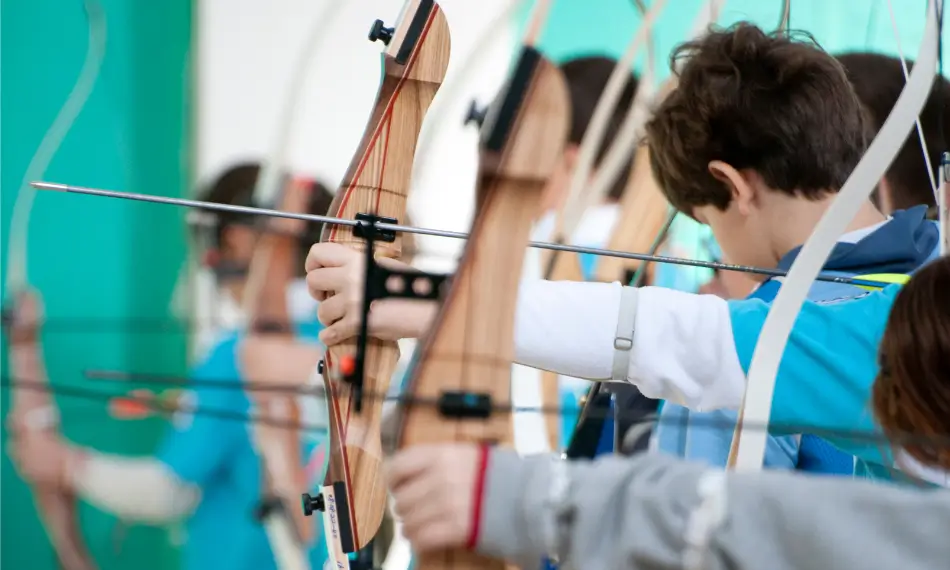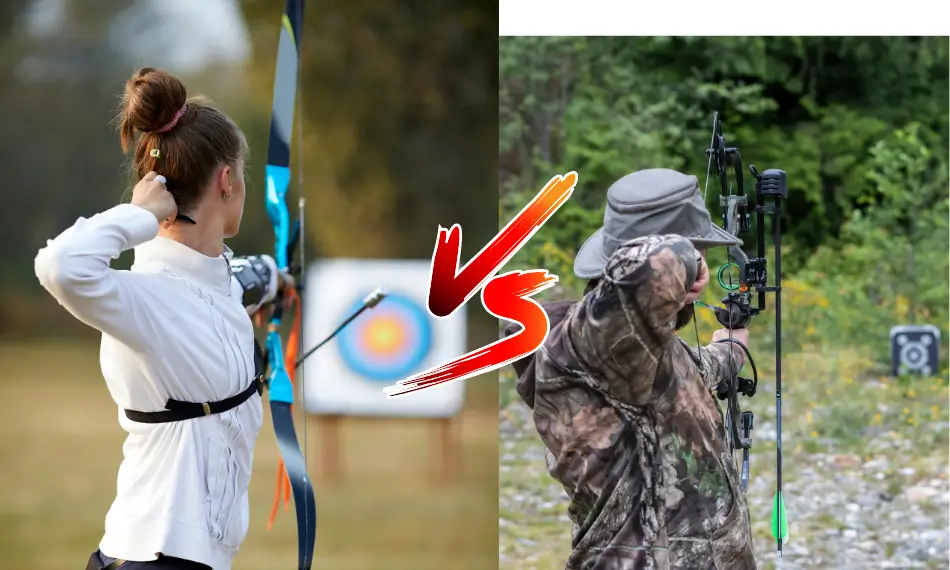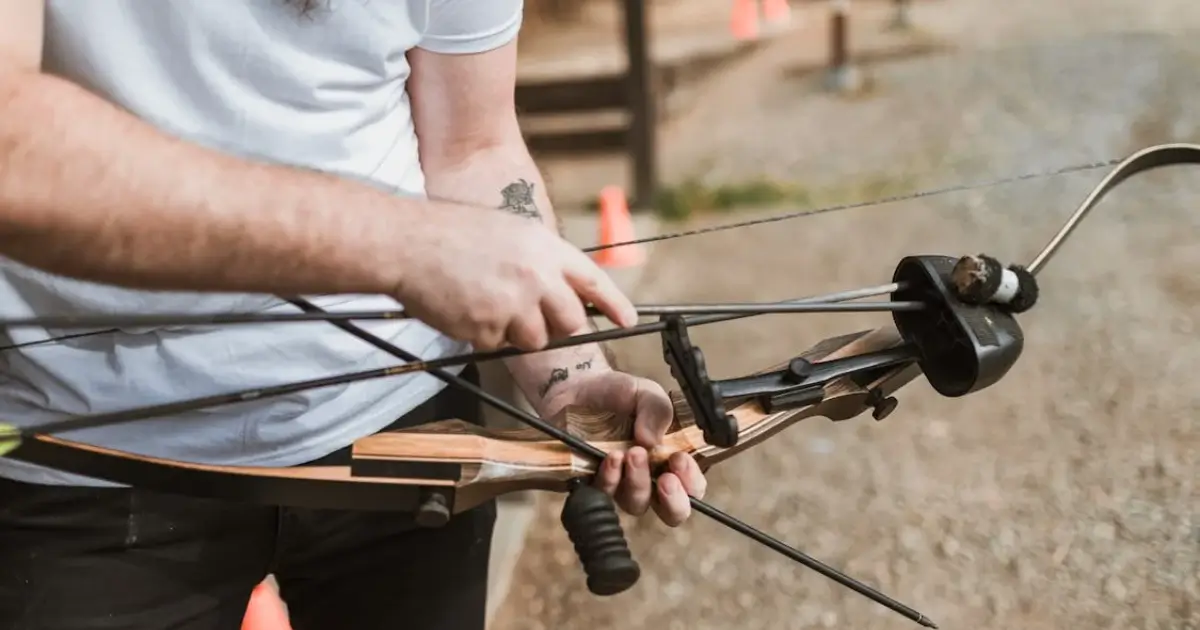The relationship between draw length and arrow length is important for optimizing archery performance, especially with recurve bows. Draw length, the distance between the bowstring and grip at full draw directly influences shooting form and accuracy. Arrow length, measured from the nock groove to the shaft’s end, ensures safety and efficiency in shooting with recurve bows. Mastering these measurements enhances consistency and precision, elevating the overall recurve bow archery experience
Draw Length vs Arrow length
Draw length refers to the distance between the nocking point on the bowstring and the deepest part of the bow grip when fully drawn. Achieving a precise measurement is crucial for optimizing shooting performance. Methods for measuring draw length include using a draw length gauge or a measuring arrow during full draw to determine the exact distance.
On the other hand, arrow length is the measurement from the nock groove to the end of the shaft, excluding the point. The correct arrow length is vital for safety and performance. An arrow that’s too short can be dangerous, while one that’s too long can impact accuracy and speed. It’s important to ensure that the arrow length complements the draw length to achieve optimal results.
Impact of Draw Length on Archery Performance
Draw length significantly influences shooting form, consistency, and accuracy in archery. It directly affects an archer’s ability to maintain a proper shooting posture and execute shots with precision. Matching the correct draw length to an archer’s physical dimensions enhances comfort and ensures consistent performance, highlighting its critical role in achieving optimal results on the range or in competition.

Arrow Length Breakdown
Arrows consist of several key components that contribute to their functionality and performance. The main parts include the shaft, which can be made of materials like carbon or aluminum, the fletching or feathers at the back that stabilize the arrow in flight, and the nock at the rear that attaches to the bowstring. These components work together to ensure the arrow flies straight and true toward the target.
Enhancing Shooting Accuracy
Choosing the right arrow length is crucial for achieving optimal shooting accuracy. An arrow that is too short may not rest properly on the arrow rest, affecting its flight path and potentially leading to inconsistent shots. Conversely, an arrow that is too long can negatively impact the bow’s performance and efficiency. By selecting the correct arrow length based on your draw length and shooting style, you can ensure that each shot is stable, precise, and effective.
Factors Influencing Draw Length
Height, arm span, and measurement techniques play pivotal roles in determining an archer’s draw length. These factors directly influence how an archer pulls and positions the bowstring during shooting. Taller archers typically have a longer draw length due to their extended arm span, whereas shorter individuals may have a shorter draw length. Accurate measurement techniques, such as using a draw length gauge or a measuring arrow, ensure precise alignment with an archer’s physical attributes, optimizing shooting form and performance.

Choosing the Right Draw Length
Archery equipment offers various options for adjusting draw length to suit individual archer preferences and needs. Many modern bows feature adjustable modules or cams that allow for easy modification of draw length without requiring a new bow purchase. This flexibility ensures that archers can fine-tune their equipment to achieve optimal shooting comfort and performance.
Types of Arrows Based on Length
Arrows are available in different materials and lengths, each offering distinct advantages based on shooting style and preference. Carbon arrows, known for their lightweight and durability, are favored in competitive archery for their consistency and speed. Aluminum arrows, while heavier, provide excellent penetration and durability, making them suitable for hunting and outdoor shooting. Understanding these variations helps archers select the most appropriate arrow type based on their specific needs and shooting goals.

Effects of Incorrect Draw Length
Using an incorrect draw length can have significant consequences on both accuracy and safety in archery. A draw length that is too short or too long can lead to inconsistent shooting form, resulting in reduced accuracy and precision. Moreover, improper draw length may cause discomfort and strain, affecting the archer’s ability to shoot comfortably and safely.
It’s essential to ensure that the draw length is properly matched to the archer’s physical attributes to minimize these risks and enhance overall shooting performance.
Adjusting Draw Length and Arrow Length
Adjusting draw length and selecting the appropriate arrow length are critical steps in optimizing archery performance. Techniques such as using a draw length gauge or a measuring arrow during full draw help archers accurately determine their ideal draw length. Additionally, tools like adjustable cams or modules on modern bows provide flexibility in modifying draw length without requiring extensive equipment changes.

Choosing the correct arrow length based on draw length ensures that each shot is stable and consistent, enhancing shooting precision and overall effectiveness on the range or in competition.
Comparing Traditional vs Compound Archery
Traditional archery typically involves longer draw lengths compared to compound archery. Traditional bows, such as longbows or recurve bows, often require drawing the bowstring farther back due to their design, which influences the length of arrows used. In contrast, compound bows utilize mechanical advantages like cams and pulleys to achieve shorter draw lengths while maintaining high arrow speeds. This difference impacts arrow length selection and shooting technique between the two archery styles.
Future Trends and Innovations
The future of archery technology is poised for exciting advancements in draw length and arrow length optimization. Innovations may focus on enhancing adjustability and customization options in bows, allowing archers to fine tune draw lengths effortlessly. Additionally, advancements in arrow materials and design could lead to improved performance characteristics such as increased speed, accuracy, and durability. Embracing these trends will likely empower archers to achieve higher levels of precision and consistency in their shooting experiences.
Conclusion
Correctly adjusting draw length and arrow length is crucial for maximizing archery performance. These factors directly impact shooting accuracy, consistency, and overall enjoyment of the sport. By leveraging modern advancements and aligning equipment with individual preferences, archers can optimize their shooting experience and achieve greater precision on the range or in competitive









Jessica Harper
Jessica Harper got into archery as a hobby, which quickly turned into a serious passion. She has become an experienced archer and knows a lot about training techniques. With a degree in Physical Education, Jessica focuses on improving accuracy and performance. She also works closely with leading manufacturers to test and review new products, providing an expert viewpoint.
Bowsclick Team Member